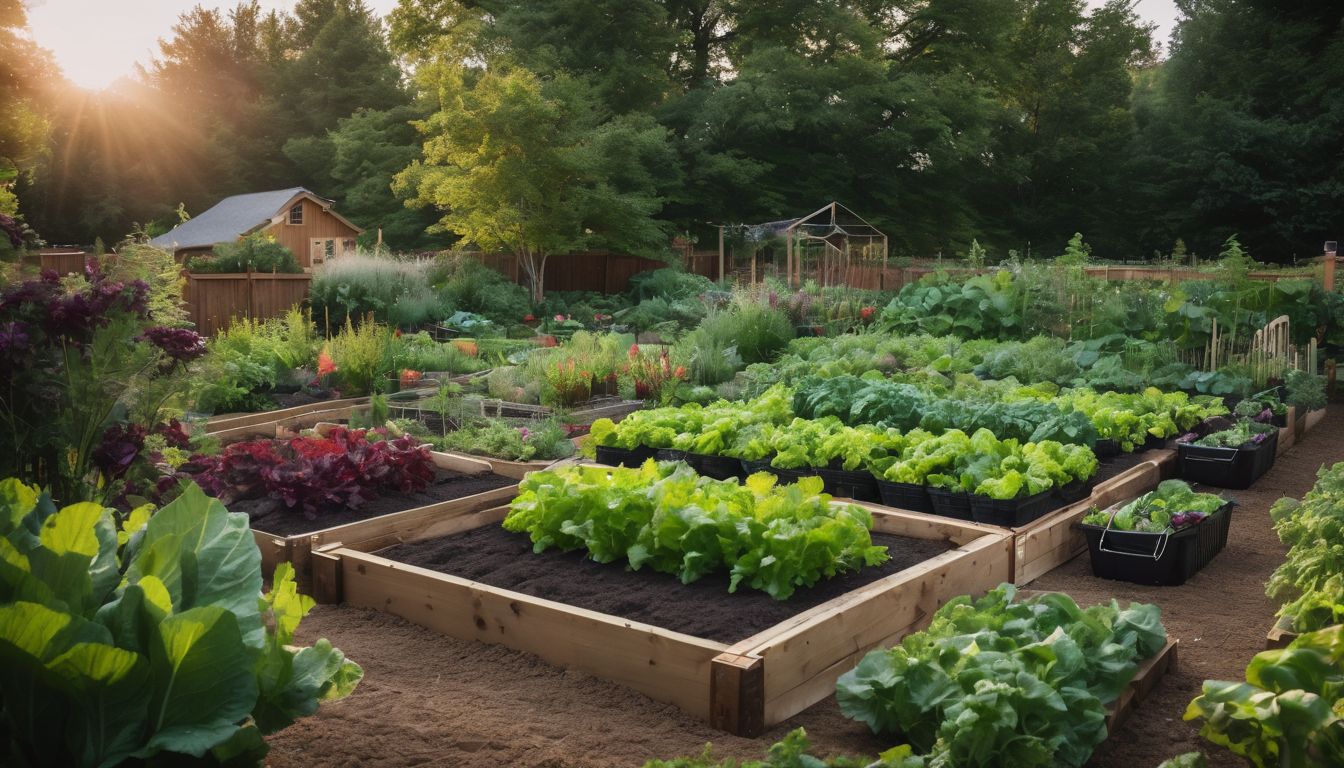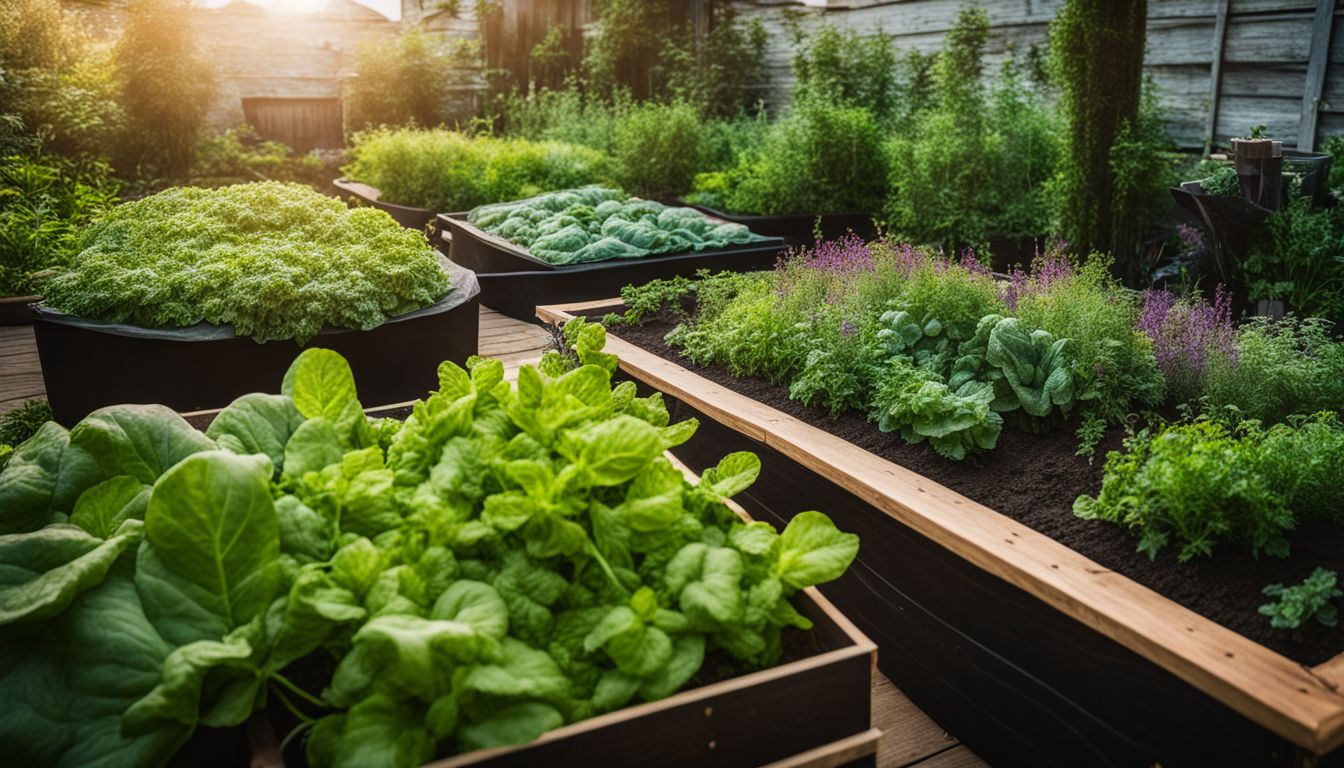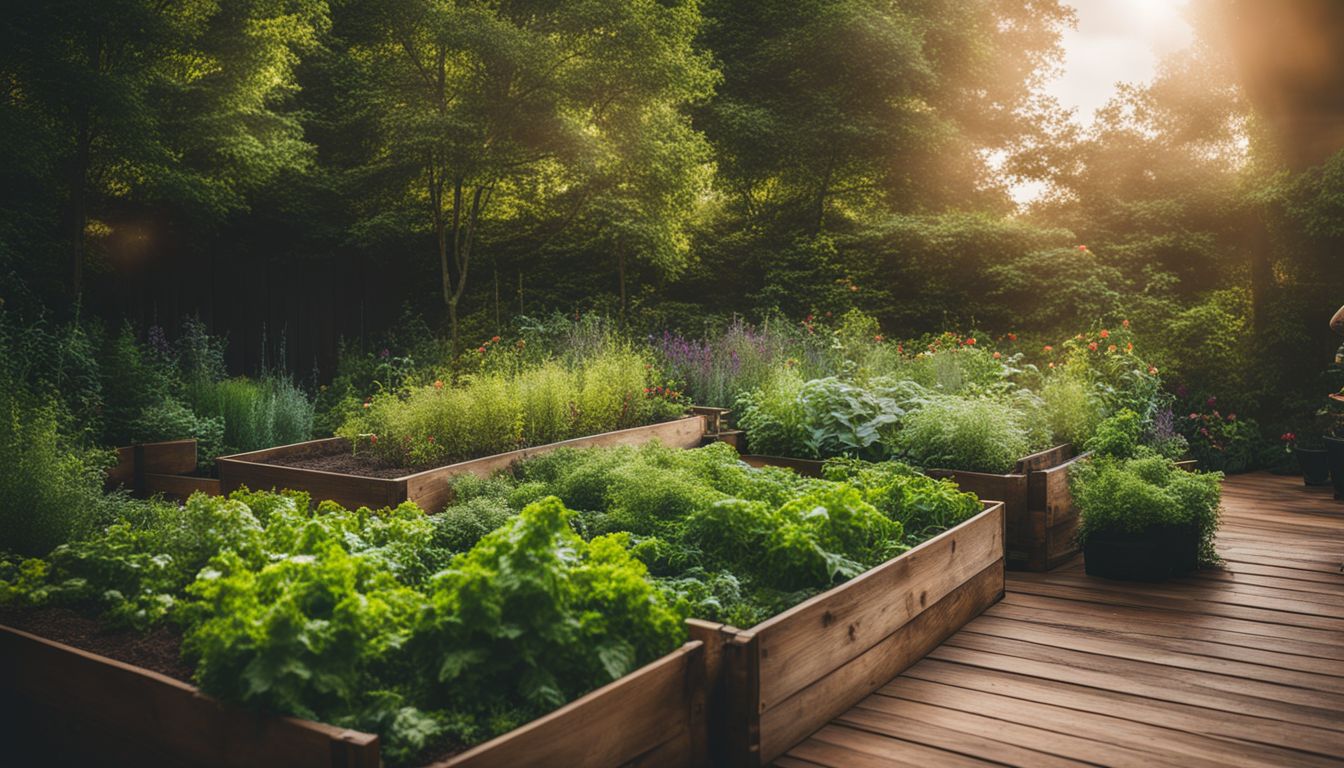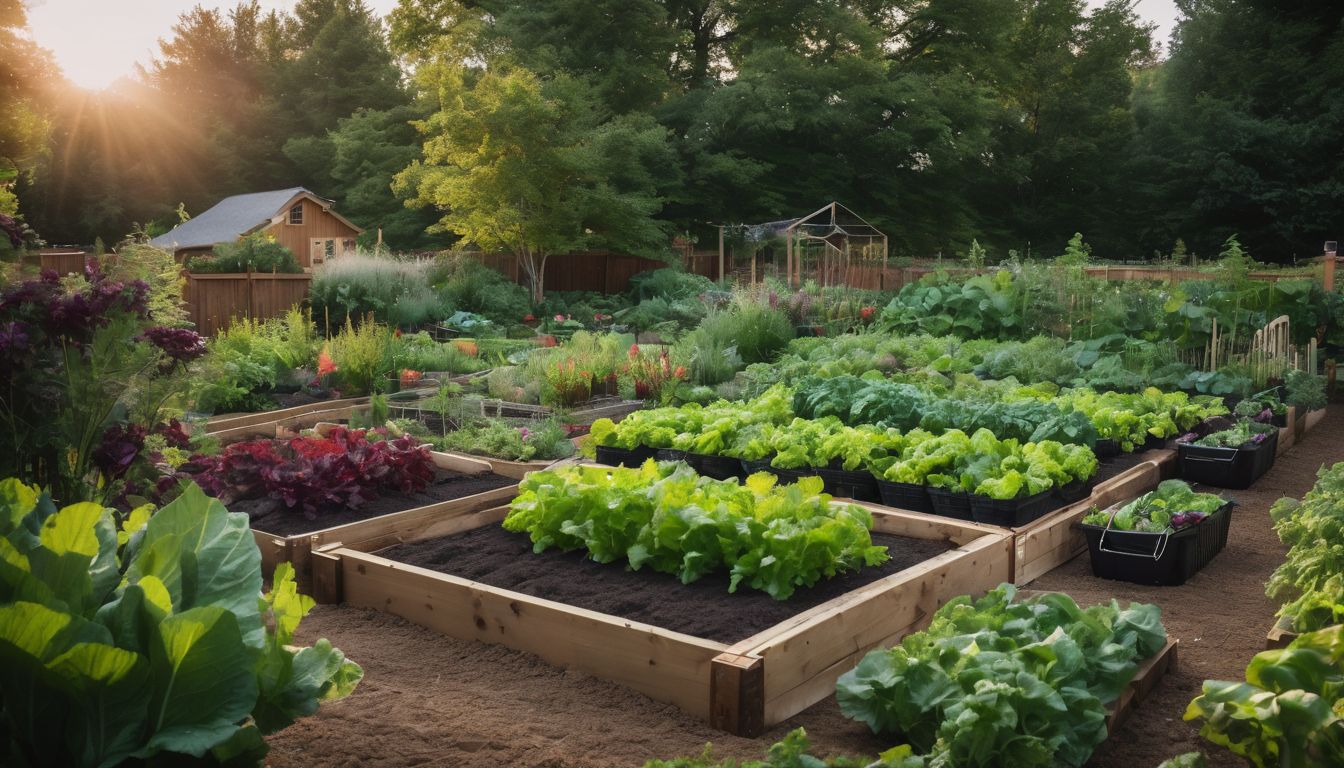TheHerbProf.com is a treasure trove of knowledge for those interested in natural healing and herbal remedies. The website is run by Paul Johnston MD. A naturopathic who has not only received extensive education in the field but also has personal experience in self-healing.
Struggling to grow your garden in poor soil or cramped spaces? Raised bed gardening is a game changer, offering high-quality soil and better plant management. This article will guide you through selecting the best plants that flourish in raised beds and maximize your harvest. Let’s dig in (no pun intended haha)!
Key Takeaways – Best Soil For Garden Beds
- Raised beds are ideal for growing root vegetables like carrots and radishes due to superior soil quality that encourages strong root development.
- Herbs such as rosemary, lavender, and sweet box thrive in raised beds because they prefer the excellent drainage conditions these gardens provide.
- Fruiting plants like tomatoes and peppers benefit from the extended growing season offered by the early warming of soil in raised beds.
- Leafy greens such as lettuce and spinach can be grown efficiently through succession planting, making perfect use of the space in raised beds with their compact growth habits.
- While raised beds are versatile, it’s best to avoid planting deep – rooted vegetables like potatoes or plants that need lots of space, such as pumpkins.
Benefits of Using Raised Beds for Gardening
Raised beds offer superior soil quality, enhanced drainage, and an extended growing season, making them ideal for planting a variety of herbs, vegetables, fruits, and flowers. They also provide ergonomic benefits, natural pest control solutions, and versatile garden design options.
Superior soil quality
One of the standout benefits of raised bed gardening is superior soil quality. Gardeners can fill their beds with a custom mix, creating an ideal environment free from rocks and compacted earth.
This type of soil offers perfect conditions for root vegetables like carrots, beets, and radishes to thrive. Rich in nutrients and organic matter, the amped-up soil promotes strong growth and bountiful harvests.
Perennial herbs such as lavender and chives also benefit greatly from this tailored approach to soil management in raised garden beds. They flourish year-round in warmer regions or resiliently reemerge each spring even in cooler climates.
The enriched soil supports their need for well-drained yet fertile ground, leading to lush growth that thrives season after season.
Enhanced drainage – Best Soil For Garden Beds
Raised beds are a game-changer for gardeners dealing with heavy rainfall or poor native soil conditions. They elevate plants away from potential waterlogging and improve air circulation around the roots, ensuring that your favorite herbs and vegetables like lavender, rosemary, and carrots thrive.
These garden structures prevent soil compaction and promote robust root development, which is essential for healthy plant growth.
Enhanced drainage also offers protection against pesky water-borne diseases and dreaded root rot. Herbs that favor drier conditions will flourish in well-drained soil found in raised-bed setups.
With these benefits, raised beds can significantly reduce garden maintenance challenges such as weeding and contribute to better yield of crops like leafy greens and fruiting vegetables.
Next up: Extended growing season – let’s explore how raised beds can unlock more time for your plants to grow!
Extended growing season – Best Soil For Garden Beds
Gardening with raised beds offers an exciting advantage: it stretches your growing season. Because the soil in raised beds warms up more quickly in spring than ground-level plots, you can get a head start on planting seeds and transplanting seedlings.
This extended period is particularly beneficial for gardeners wanting to grow warmth-loving crops like tomatoes, peppers, cucumbers (Cucumis sativus), and melons (Citrullus lanatus).
It means more time for these plants to mature and produce their tasty fruits.
A longer season can also increase your yield from fast-growing salads greens such as lettuce (Lactuca sativa) and spinach (Spinacia oleracea), allowing you multiple harvests before summer’s heat sets in.
With thoughtful planning and crop rotation, consecutive plantings ensure a continuous supply of fresh veggies right from your backyard. By optimizing the advantages of an extended growing season, urban gardening becomes even more productive and fulfilling.
Ergonomic benefits – Best Soil For Garden Beds

Raised beds offer significant ergonomic benefits, reducing the strain of traditional gardening by providing a more accessible and comfortable platform for tending to plants. With raised beds, gardeners can minimize bending and kneeling, promoting better posture and less strain on the back and knees during planting, weeding, and harvesting.
This accessibility is particularly beneficial for individuals with mobility issues or physical limitations.
Additionally, the elevated height of raised beds facilitates easier reach to all areas of the garden without having to stoop or stretch excessively. This not only reduces physical discomfort but also makes tasks such as watering, pruning, and inspecting plants much more manageable.
Natural pest control
Intensive planting in raised beds provides a natural way to control pests, reducing the need for chemical interventions. Flowers such as nasturtiums and dill not only add beauty but also attract beneficial insects that prey on garden pests like aphids and caterpillars.
This mutually beneficial relationship creates a balanced ecosystem, promoting a healthy garden without the use of harmful pesticides.
To further enhance natural pest control in your raised beds, consider integrating companion plants such as thyme and swiss chard to deter unwanted insect visitors while supporting the growth of your main crops.
Versatility and aesthetic appeal
After considering natural pest control, it’s essential to acknowledge the versatility and aesthetic appeal of raised beds for gardening. Raised beds offer a wide range of design options and can be created from various materials such as wood, metal, or stone, adding an attractive visual element to outdoor spaces.
Gardeners can customize the size and shape of their raised beds according to their preferences, allowing for endless creativity in creating visually appealing garden layouts. Additionally, raising plants above ground level not only makes them more accessible but also adds dimension and interest to the overall garden design.
The flexibility of raised bed gardens allows for diverse planting arrangements that contribute to their aesthetic appeal. Whether growers opt for traditional rows or experiment with interplanting different crops, raised beds enable them to curate stunning displays while maximizing space usage within the garden.
Best Plants for Raised Beds

Herbs like rosemary, lavender, allium, and sweet box thrive in the well-drained soil of raised beds. Vegetables such as carrots, cucumbers, and radishes also do well in this environment.
Additionally, fruiting plants like tomatoes and peppers are great choices for raised beds due to their ability to produce bountiful crops.
Herbs (rosemary, lavender, allium, sweet box) – Best Plants For Raised Beds
Rosemary, lavender, allium, and sweet box are top choices for raised beds. These herbs provide year-round color, attract beneficial insects like bees, and offer vertical interest that enhances the overall design of a raised bed garden.
They prefer well-drained soil with specific types recommended for each herb to thrive optimally.
Sweet box, also known as winter box or sarcococca, is particularly suited for raised beds in shady spots and produces berries in the summer. This makes it an excellent choice for adding interest to partially shaded areas within a raised bed garden.
Vegetables (carrots, cucumbers, radishes)
Carrots, cucumbers, and radishes are perfect for raised beds due to their compact growth habits. Their small root systems make them ideal choices for maximizing space in a raised bed environment.
Additionally, these vegetables thrive in the nutrient-rich soil of raised beds and benefit from the enhanced drainage that these gardening structures provide. With minimal effort, gardeners can enjoy an abundant harvest of fresh carrots, crisp cucumbers, and flavorful radishes from their raised beds.
These vegetables also lend themselves well to companion planting strategies, enhancing each other’s growth while naturally deterring pests. For instance, planting radishes alongside cucumbers can help deter cucumber beetles that may otherwise damage cucumber plants.
Fruiting plants (tomatoes, peppers) – Best Plants For Raised Beds
Fruiting plants such as tomatoes and peppers are excellent choices for raised beds due to their adaptability and productivity. These compact plants can thrive in the nutrient-rich soil of raised beds, producing an abundant harvest within a limited space.
Additionally, trellising these plants in raised beds allows for vertical growth, maximizing the available area for cultivation while ensuring good air circulation and sunlight exposure.
Small fruiting varieties like cherry tomatoes and bell peppers are particularly well-suited for confined spaces within raised beds. Their ability to flourish in containers makes them ideal candidates for this gardening method, offering a bountiful yield without sacrificing valuable garden real estate.
Leafy greens (lettuce, spinach) – Best Soil For Garden Beds
Lettuce and spinach are prime choices for raised beds due to their compact nature, making them ideal for maximizing space. These leafy greens flourish in the nutrient-rich soil of raised beds, providing an abundance of vitamins and minerals in return.
With the ability to replant after harvest, these greens offer a continuous supply over the growing season. The deep roots of lettuce and spinach have ample room to access nutrients in the well-draining soil of raised beds.
Additionally, intensive planting techniques allow for growing several varieties of lettuce and spinach within limited space, making them perfect options for those looking to make the most of their raised bed garden.
Flowers (cosmos, cornflower) – Best Plants For Raised Beds
Add vibrant pops of color and attract beneficial insects to your raised garden beds by planting cosmos and cornflowers. These beautiful flowers not only enhance the aesthetic appeal but also play a vital role in attracting pollinators like bees and butterflies.
Adding these flowers to your raised beds can contribute to a healthier garden ecosystem, promoting the growth of other plants while beautifying your outdoor space.
Cosmos and cornflowers are easy-to-grow annuals that thrive in sunny locations with well-drained soil, making them ideal choices for raised garden beds. Their low maintenance nature and ability to reseed themselves make them a valuable addition to any gardening space, offering continuous bursts of color throughout the growing season.
Tips for Sowing and Growing in Raised Beds
When it comes to sowing and growing in raised beds, proper soil preparation is essential for success. Spacing and depth should be carefully considered, along with effective watering techniques and the use of mulching for weed control.
Succession planting and companion planting can also maximize your harvest in a small space.
Soil preparation – Best Plants For Raised Beds
Soil preparation is crucial for successful raised bed gardening. Start by removing any existing vegetation or weeds from the designated area. Then, loosen the soil using a garden fork or tiller to improve aeration and drainage.
Incorporate organic matter like compost or aged manure into the soil to enhance its fertility and structure. Consider adding balanced fertilizer based on a soil test to ensure optimal nutrient levels for plant growth in the raised beds.
After amending the soil, use a rake to level the surface and create smooth planting beds within your raised garden. This thorough soil preparation sets the stage for healthy plant development and productive yields in your raised beds by providing an ideal growing environment with improved drainage, better nutrient retention, and enhanced root penetration.
Spacing and depth – Best Plants For Raised Beds
To ensure optimal growth, it’s crucial to space and plant crops at the appropriate depths in raised beds. The depth of the bed should match the needs of the plants, with root vegetables like carrots and beets requiring deeper soil than herbs or lettuces.
Adequate spacing between plants is also essential for proper airflow, sunlight penetration, and access to nutrients, promoting healthy development and minimizing competition among neighboring plants.
Trellises can further maximize space by allowing climbing plants such as cucumbers or tomatoes to grow vertically, optimizing the use of limited space while facilitating easier harvests.
Watering techniques – Best Soil For Garden Beds
After you’ve carefully spaced and planted your crops, it’s crucial to implement effective watering techniques to ensure their healthy growth. One key approach is drip irrigation, which delivers water directly to the plants’ roots, reducing evaporation and minimizing weed growth.
Additionally, soaker hoses can be snaked through the raised beds, providing a slow and steady release of moisture right where it’s needed most. This method not only conserves water but also helps prevent disease by keeping foliage dry.
Mulching around plants with wood chips or straw serves as another vital technique for retaining soil moisture while preventing weeds from competing for water and nutrients with your chosen vegetation.
Mulching – Best Plants For Raised Beds
After addressing the importance of proper watering techniques, it’s essential to consider mulching as a key aspect of maintaining healthy plants in raised beds. Mulching plays a crucial role in retaining moisture and regulating soil temperature, promoting optimal growing conditions for various plants.
Additionally, organic mulches like straw, wood chips, or compost are highly recommended for raised beds due to their ability to suppress weed growth and improve soil structure and fertility.
When applying mulch around plants in raised beds, be sure to layer it evenly at a depth of 2-4 inches to effectively protect plant roots from temperature fluctuations and erosion while providing an ideal environment for growth.
Succession planting – Best Plants For Raised Beds
Succession planting is a savvy technique that maximizes the potential of raised beds by staggering the planting of different crops. This approach optimizes space and extends the growing season, ensuring a continuous harvest.
By strategically sowing quick-growing vegetables like lettuce and spinach after harvesting early-season crops, gardeners can make the most of their raised bed gardens and enjoy a variety of fresh produce throughout the season.
With succession planting in raised beds, gardeners can capitalize on favorable soil conditions to cultivate multiple rounds of crops like peas and radishes. This method not only boosts productivity but also enhances the efficiency of gardening efforts, providing an ongoing abundance of homegrown delights while making efficient use of valuable space.
Companion planting – Best Plants For Raised Beds
Companion planting in raised beds offers numerous benefits, such as natural pest control and maximizing space and yield. By combining specific plants, gardeners can create a balanced ecosystem within their raised beds.
Basil with tomatoes, marigolds with beans, and onions with carrots are popular companion plant combinations that help repel pests and attract beneficial insects. With different combinations to experiment with, gardeners can customize their raised bed gardens to suit their unique growing conditions and goals.
Exploring the world of companion planting in raised beds opens doors to a myriad of possibilities for creating thriving gardens. These strategic plant combinations not only enhance growth but also contribute to the overall health of the garden ecosystem.
Pest and disease management
Proper spacing and mulching in raised beds can help control pests and diseases. Good air circulation, aided by proper plant spacing, reduces the risk of disease by preventing moisture buildup.
Mulching controls pests and diseases by maintaining soil moisture levels while reducing weed competition.
Crop rotation and companion planting in raised beds are effective management strategies for pests and diseases. These practices disrupt pest life cycles and attract beneficial insects that help control harmful ones, contributing to a healthier growing environment within the raised beds.
What Not to Plant in Raised Beds and Why – Best Plants For Raised Beds
Avoid planting vegetables with deep roots like potatoes and zucchinis as they can compete for space in the raised bed. Also, be cautious of plants that attract pests or spread quickly, such as tomatoes and leopard plants, which can cause issues in the confined space of the raised beds.
Vegetables with deep roots (potatoes, zucchini)
Potatoes and zucchini, which have deep roots and require ample space to grow, are not well-suited for raised beds. Their extensive root systems can crowd out other plants in the limited space of a raised bed, hindering their growth and productivity.
These vegetables thrive best when given room to spread out in traditional ground row-garden settings where they can maximize their growth potential without encroaching upon neighboring plants.
Zucchini especially needs significant space to sprawl as it produces large fruiting plants. Planted in conventional garden setups, they can freely expand horizontally without competing with other crops.
Plants that require a lot of space (pumpkins)
Plants like pumpkins, melons, and gourds are known for their sprawling nature and large space requirements. Raised beds may not provide the necessary room for these plants to spread out and thrive.
Therefore, it’s recommended to plant them in traditional ground row-garden style where they have ample space to grow and flourish. Trellises can also be used for some fruiting plants in raised-bed gardens to ensure they have the vertical space needed to prosper.
Plants that attract pests (tomatoes) – Best Plants For Raised Beds

Tomatoes, while beloved for their flavor and versatility in culinary applications, are prone to attracting pests. Common tomato pests include aphids, hornworms, flea beetles, and whiteflies.
These pests can quickly infest a garden bed and spread to other plants if not managed effectively. Furthermore, the large foliage of tomato plants can create dense cover that attracts pests seeking shelter from predators or adverse weather conditions.
Therefore, it’s advisable to consider alternate growing methods such as grow bags or containers for tomatoes to minimize the risk of pest infestation.
To deter these pesky critters naturally, companion planting with basil can help repel aphids and hornworms due to its strong scent. Additionally, marigolds serve as natural insect repellents when planted around tomato beds.
Plants that spread quickly (leopard plant)
In contrast to plants that attract pests like tomatoes, leopard plant is a rapid spreader and can thrive in raised beds. Its ability to spread quickly makes it a suitable addition to the mix of herbs, vegetables, and flowers commonly found in these beds.
The intensive planting approach often employed in raised beds allows for incorporating leopard plants alongside other beneficial flora while attracting pollinators like butterflies and bees.
Leopard plant’s adaptability to the conditions provided by raised garden beds makes it an appealing option for filling out the available space within such confined areas.
Before You Go – Best Plants For Raised Beds
When choosing plants for raised beds, consider the specific needs and growing habits of each variety. Different plants thrive in this environment due to superior soil quality and improved drainage.
To get the most out of your raised bed garden, select a mix of herbs, vegetables, fruiting plants, leafy greens, and flowers that complement each other well. Understanding which plants are best suited for raised beds will help you maximize your gardening efforts and enjoy a bountiful harvest throughout the growing season.
Linking “Best Plants For Raised Beds” to The Herb Prof
Raised beds, they’re a gardener’s dream! They offer better drainage, easier maintenance, and a boost to plant health.
Now, you might be thinking, “What’s this got to do with The Herb Prof?” Well, let me tell you! The Herb Prof is your go-to guide for all things herbal. We’ve got the scoop on which plants thrive in raised beds.
By linking our raised bed discussion to The Herb Prof, we’re creating a garden of knowledge. You learn about these wonderful plant options, and then you can hop over to The Herb Prof to learn even more about herbs and their uses.
So, the next time you’re planning your raised bed garden, remember this: The Herb Prof is here to help you make the most of it. Now, isn’t that a growing idea?
References – Best Plants For Raised Beds
Little Herb Encyclopedia, by Jack Ritchason; N.D., Woodland Publishing Incorporated, 1995
The Ultimate Healing System, Course Manual, Copyright 1985, Don Lepore
Planetary Herbology, Michael Tierra, C.A., N.D., Lotus Press, 1988
Handbook of Medicinal Herbs, by James A. Duke, Pub. CRP Second Edition 2007
The Complete Medicinal Herbal, by Penelope Ody, Published by Dorling Kindersley
Check the Following Articles!
Raspberry Companion Plants: Unleash the Full Potential
Companion Plants For Rhubarb: Discover The Top 5
Do Cherry Tomato Plants Die After Harvest: Explained
FAQs – Best Plants For Raised Beds
1. What vegetables grow well in raised beds?
Raised beds are great for growing a variety of vegetables like salad greens, bush beans, cauliflower, and carrot-family veggies such as daucus carota.
2. Can I plant herbs with my vegetables in a raised bed?
Absolutely! Oregano, lavender varieties like ‘Miss Jessop’s Upright’, and other culinary herbs thrive alongside vegetables in raised beds.
3. How do I manage water needs for plants in raised beds?
Soil drainage is key for plants in raised gardens; adding mulch can help retain moisture and using cold frames protects against too much water from rain.
4. Are there benefits to planting flowers in my vegetable garden?
Yes, flowers like fragaria x ananassa (strawberry) or tropaeolum majus add color and attract pollinators which help your vegetable gardens flourish!
5. What’s the best way to utilize space in my raised bed garden?
Try square foot gardening or vertical gardening techniques to maximize space – this means more mixed greens, beta vulgaris (beet plant), or even allium cepa (onion).
6. Should I rotate crops in my raised vegetable garden?
Rotating crops each growing season helps prevent soil diseases and keeps nutrients balanced, so be sure to swap out where you plant items like raphanus sativus (radish) or ipomoea batatas (sweet potato).


